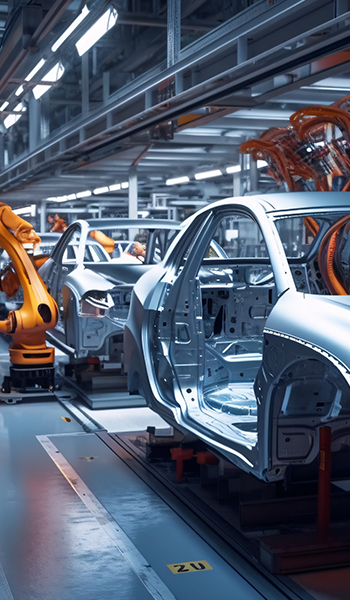Quality Control and Inspection
Surface Defect Detection:
Vision systems are used to detect surface imperfections such as scratches, dents, rust, or paint defects on vehicle parts. This ensures that components such as body panels, bumpers, and doors meet high-quality standards.
Assembly Verification:
Vision systems inspect the assembly of parts and components, checking for correct part placement, alignment, and proper fitting. For example, in the final assembly line, systems check if components like windows, headlights, or doors are correctly installed.
Weld Inspection:
In automotive manufacturing, where welding is essential, machine vision systems can check the quality of welds, identifying any gaps, cracks, or incomplete welds. This ensures that structural integrity is maintained.
Dimensional and Geometric Measurement
Component Measurement:
Vision systems can precisely measure the dimensions of automotive components to ensure that they meet design specifications. This is crucial for critical parts like engine components, chassis, and suspension systems that need to adhere to tight tolerances.
Alignment and Positioning:
Vision systems are used to guide robotic arms in aligning and positioning parts during assembly. For instance, they help ensure that parts such as doors, hoods, and fenders are installed in the correct positions.
Part Identification and Traceability
Barcode and QR Code Reading:
Vision systems are used to scan barcodes or QR codes on parts, ensuring proper identification, tracking, and traceability. This helps maintain a clear record of each part’s origin and journey through the production process.
Serial Number Verification:
Ensuring that each vehicle and its components are accurately labeled with unique serial numbers is vital for traceability, recalls, and regulatory compliance.
Robot Guidance and Automation
Vision-Guided Robotics (VGR):
Vision systems enable robots to perform tasks like part picking, placing, welding, and even assembly. Vision-guided robots can “see” and adapt to the parts they handle, ensuring precise placement, alignment, and handling of automotive components.
Automated Material Handling:
Machine vision systems help robots or conveyors identify parts as they move through the production line, ensuring proper sorting, placement, and handling.
End-of-Line Testing
Safety Feature Testing:
Vision systems can be used at the end of the production line to test safety features such as airbags, sensors, and seatbelt systems. This ensures that these critical features are installed and function properly before the vehicle is shipped to dealers.
Benefits for Automobile Manufacturers:
- Improved Product Quality: Vision systems ensure that all components, assemblies, and finished vehicles meet the highest quality standards by detecting defects early in the production process. This leads to higher quality, fewer recalls, and better customer satisfaction.
- Increased Production Efficiency: Automating quality inspections, assembly verification, and robot guidance speeds up production lines while reducing the need for manual labor. This increases throughput and reduces bottlenecks.
- Cost Savings: Automation of repetitive tasks such as inspection, part sorting, and assembly verification reduces labor costs and minimizes human error, which can lead to costly mistakes and defects.
- Enhanced Accuracy and Precision: Vision systems provide highly accurate and consistent measurements, which are critical in the automotive industry, where tolerances are tight, and parts need to fit perfectly.
- Real-Time Process Control: Vision systems provide real-time feedback on production quality, enabling operators to make quick adjustments to ensure that the process remains on track. This helps in preventing defects and ensuring consistency across all stages of production.
- Regulatory Compliance and Traceability: Machine vision systems help ensure that parts are properly tracked, labeled, and verified, which is critical for meeting regulatory requirements and for managing vehicle recalls when necessary.
- Faster Time to Market: With efficient, automated inspections and robot guidance, production lines move faster, reducing the overall time it takes to produce and ship vehicles. This helps automotive manufacturers remain competitive.

